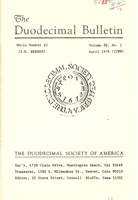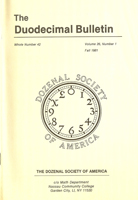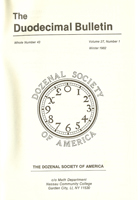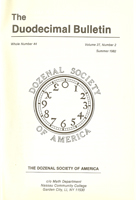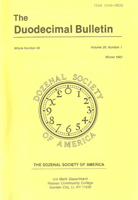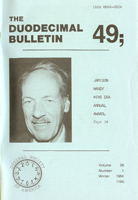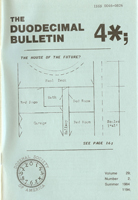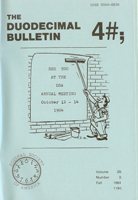240-40
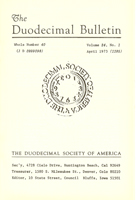
The last issue of the “classic” phase of the Duodecimal Bulletin, edited by Henry Clarence Churchman, is published in 1974. It replaces the “classical” transdecimal numerals crafted by William Addison Dwiggins with the “Bell” numerals inspired by the touch tone telephone characters * and #.
The Duodecimal Bulletin enters a six year unplanned hiatus wherein two of the Founders (Messrs. Beard and F. Emerson Andrews) and an active President Tom Linton pass away. At one point, mentioned in Vol. 26; No. 1 Page 4, the DSA considered scrapping its Bulletin and combining dozenal publication with the Dozenal Society of Great Britain.
Editor Dr. Patricia Zirkel’s Volume 26; No. 1 represents the relaunching of The Duodecimal Bulletin under a “new generation” of American organized dozenalists. Over the next dozen issues, the proceedings of the Society during the hiatus years are recapped. This “second generation” of Society leaders, more academic than their predecessors, breathes new life and vigor in the organization and its Bulletin. In nothing short of a renaissance, the Society forges connections with mathematics journals and organizations. The Bulletin becomes a peer-reviewed journal. The Society finds a new home at Nassau Community College, complete with a Duodecimal Library dedicated to F. Emerson Andrews, a founder of the DSA. Reporter Irene Virag visits the 1982 Annual Meeting, her report appears in print across the nation, in the Toronto Star and others, and on Los Angeles radio, the publicity netting new Members. Prof. Jay Schiffman pens number theoretical essays revolving around the special number twelve. Prof. Gene Zirkel explores symbology, how we write dozenal numbers. Some articles yet press against the SI-metric system, but the focus of the new generation lies somewhat more serenely on the qualities and mathematics of the dozen. The Society explores its own Members in the “Who We Are” series. All caught up, the DSA returns to a vibrancy it last saw long before the hiatus, and The Duodecimal Bulletin begins more than two dozen years of strong and steady publication heretofore unseen.

